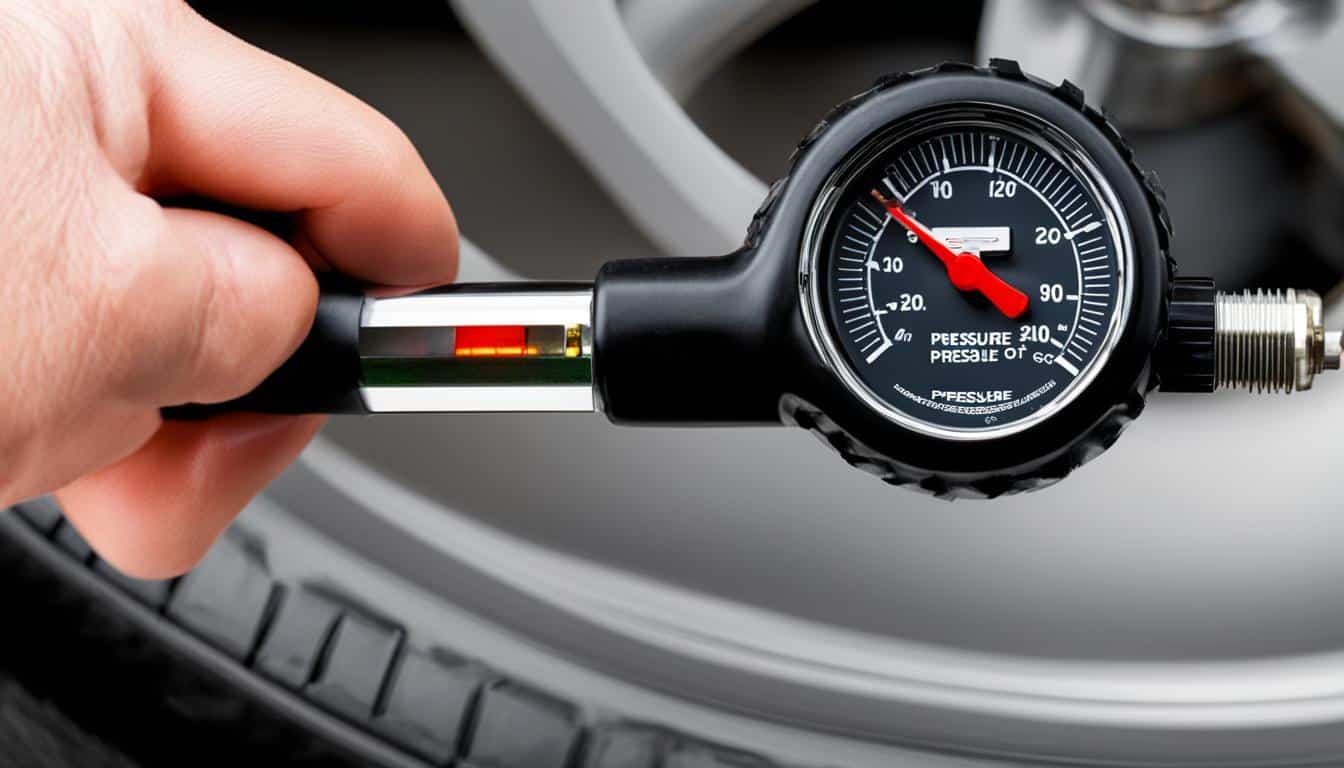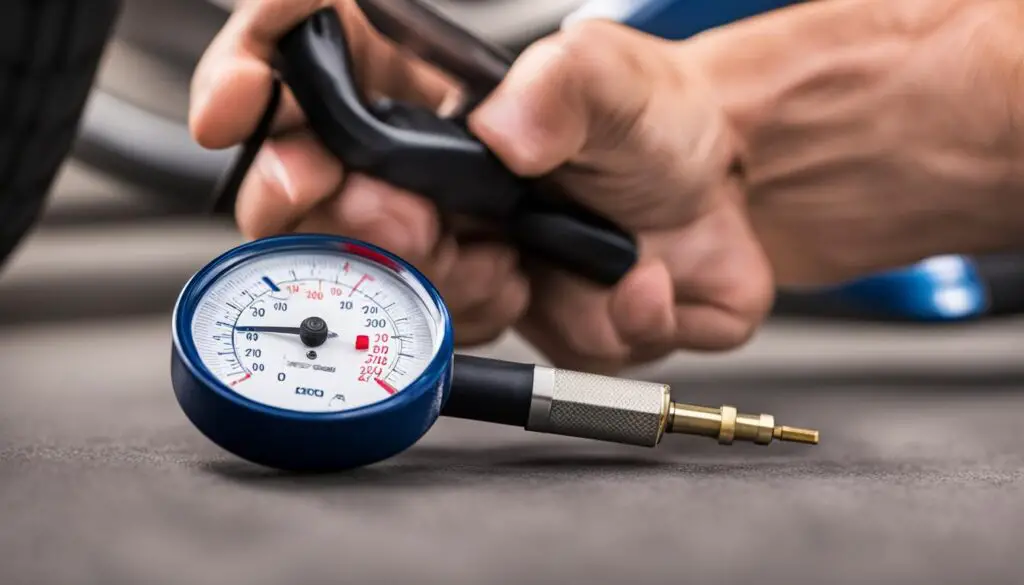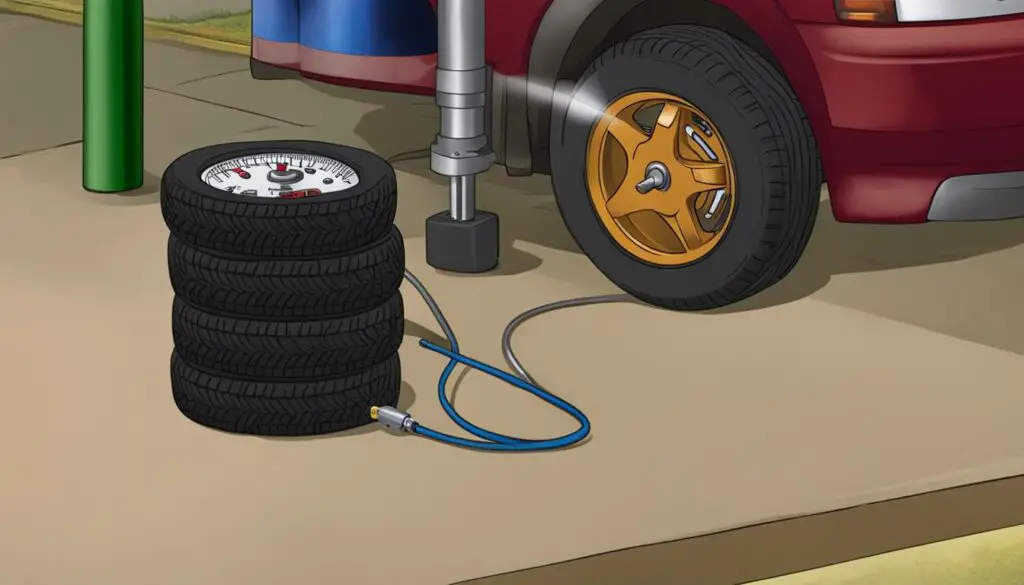
A Complete Guide to Car Tire Pressure Management
Welcome to my comprehensive guide on managing car tire pressure. As a professional journalist, I understand the importance of proper tire pressure maintenance and the impact it has on vehicle performance and safety. In this section, I will provide you with essential tips and techniques to manage your car’s tire pressure effectively.
Did you know that proper tire pressure maintenance can improve fuel efficiency, extend tire life, and enhance braking performance? Maintaining the recommended tire pressure not only saves you money but also helps prevent accidents caused by blowouts, flats, and poor handling.
Regularly checking and maintaining your car tire pressure is a simple task that has many positive outcomes in the long run. By incorporating some of the best practices, you can avoid costly repairs and keep your car running smoothly.
Key Takeaways:
- Proper tire pressure maintenance leads to improved fuel efficiency, extended tire life, and enhanced braking performance.
- Regularly checking and maintaining tire pressure ensures safety on the road and prevents accidents caused by blowouts, flats, and poor handling.
- Following best practices for car tire pressure management can help avoid costly repairs and keep your car running smoothly.
- Proper tire pressure maintenance is a simple yet crucial task that should not be overlooked.
- Recommended tire pressure varies based on the type and size of the tire, and it is essential to follow the manufacturer’s guidelines.
Understanding Tire Pressure and Its Impact on Vehicle Performance
As a car owner, it is essential to understand the importance of managing car tire pressure. Proper car tire pressure maintenance not only ensures a safer driving experience but also improves vehicle performance. In this section, I’ll discuss the benefits of managing car tire pressure and the best practices to follow.
Benefits of Managing Car Tire Pressure
- Improved Fuel Efficiency: Maintaining proper tire pressure helps to improve fuel efficiency by reducing rolling resistance, which ultimately saves you money on gas.
- Extended Tire Life: Overinflated or underinflated tires can cause uneven wear and tear, leading to a shorter tire life. By properly managing tire pressure, you can extend the life of your tires.
- Better Handling and Braking: Properly inflated tires provide better handling and braking, ensuring a safer driving experience. Underinflated tires can affect the vehicle’s ability to stop quickly, while overinflated tires can cause the vehicle to bounce and lose traction.
Best Practices for Car Tire Pressure Management
The following are some best practices for managing car tire pressure:
| Best Practices | Explanation |
|---|---|
| Check Tire Pressure Regularly | It is recommended to check tire pressure at least once a month to maintain optimal tire performance. |
| Refer to Vehicle Manufacturer Guidelines | Check your vehicle’s owner manual to determine the recommended tire pressure levels. |
| Test Tire Pressure When Tires are Cold | It is recommended to check tire pressure when the tires are cold, as hot tires can lead to inaccurate pressure readings. |
| Adjust Tire Pressure as Needed | If the tire pressure is too low or high, adjust it accordingly. Make sure to not overinflate the tires, as it can cause them to burst. |
| Replace Damaged or Worn Tires | Inspect tires regularly for damage or wear and replace them as needed to ensure optimal vehicle performance and safety. |
By following these best practices, you can effectively manage your car’s tire pressure and ensure optimal vehicle performance and safety.

Tips for Effective Car Tire Pressure Management
Proper tire pressure management is crucial for your car’s safety and performance on the road. Here are some tips and techniques for effectively managing your car’s tire pressure:
1. Check Your Tire Pressure Regularly
Regularly checking your tire pressure is the first step in ensuring optimal car performance and safety. You should check your tire pressure at least once a month or before long trips. Use a tire pressure gauge to measure the pressure in each tire. The recommended tire pressure for your car can be found in the owner’s manual or the tire information placard located inside the driver’s door.
2. Inflate or Deflate Tires as Needed
Underinflated or overinflated tires can lead to poor fuel economy, tire wear, and decreased vehicle performance. If your tire pressure is too low, use an air compressor to inflate the tires to the recommended pressure level. If your tire pressure is too high, use a tire pressure gauge to release air until it reaches the recommended level.
3. Learn Proper Tire Maintenance Techniques
Knowing how to maintain your tires is key to achieving optimal tire performance and extending their lifespan. Regular tire rotation, balancing, and alignment can go a long way in keeping your tires in good shape and ensuring smooth driving. Consult your owner’s manual for recommended maintenance schedules and tips on proper tire care.
4. Use Quality Tires and Replace Them When Necessary
Using quality tires and replacing them in a timely manner is important for optimal car performance and safety. Check your tires periodically for visible wear and tear, uneven tread wear, or punctures. If you notice any of these issues, have your tires inspected by a professional and replace them if needed.
5. Drive Responsibly
How you drive your car can also impact tire performance and lifespan. Avoid sudden acceleration or braking, take turns at moderate speeds, and avoid driving on rough roads or over potholes whenever possible. These practices can help maintain your tires and reduce the risk of damage or wear.

“Proper tire pressure management is crucial for optimal car performance and safety. By following these tips and techniques, you can ensure your tires are in good shape and enjoy a smoother, more efficient driving experience.”
Tips for Effective Car Tire Pressure Management
As I have previously mentioned, managing car tire pressure is crucial for optimal performance and safety. Here are some practical tips and techniques to effectively manage your car’s tire pressure:
Regularly Check Tire Pressure
It is important to regularly check your car’s tire pressure, ideally once a month. Use a reliable tire pressure gauge to measure the pressure, and compare it to the recommended pressure listed in your car’s owner manual or on the inside of the driver-side door. If the pressure is too high or too low, adjust it accordingly.
Inflate or Deflate Tires When Necessary
If your tire pressure is too low, inflate the tires using an air pump until they reach the recommended pressure. On the other hand, if the pressure is too high, use a pressure gauge to release some air until it reaches the recommended level. It is important to note that tire pressure can fluctuate due to changes in temperature, so always check and adjust as necessary.
Rotate Tires Regularly
Rotating your tires every 5,000 to 7,000 miles can help evenly distribute wear and tear, which can prolong the life of your tires. This can also help maintain good tire pressure, as well as improve handling and performance.
Replace Worn Tires
It is important to replace worn or damaged tires as soon as possible, as they can affect your vehicle’s performance and safety. Check your tires regularly for signs of wear, such as cracks, bulges, or low tread depth. If you notice any issues, have your tires inspected by a professional mechanic.
Maintain Proper Alignment
Proper wheel alignment can help your tires wear evenly and improve fuel efficiency. Have your alignment checked regularly, especially after hitting a pothole or curb, or if you notice uneven wear on your tires. A professional mechanic can help adjust your alignment as necessary.
By following these tips and techniques, you can effectively manage your car’s tire pressure and ensure optimal performance and safety on the road. Remember to regularly check and maintain your tire pressure for the best results.
FAQ
Why is managing car tire pressure important?
Managing car tire pressure is important because it affects vehicle performance, safety, and fuel efficiency. Properly inflated tires provide better traction, handling, and braking. They also help extend tire life and reduce the risk of blowouts.
How often should I check my car’s tire pressure?
It is recommended to check your car’s tire pressure at least once a month or before long trips. Temperature changes can cause fluctuations in tire pressure, so it’s crucial to monitor it regularly to ensure optimal performance.
How do I check my car’s tire pressure?
To check your car’s tire pressure, you will need a tire pressure gauge. Remove the valve cap from the tire, press the gauge onto the valve stem, and read the pressure displayed. Compare it with the manufacturer’s recommended pressure, which can be found in your vehicle’s owner’s manual or on a sticker inside the driver’s door jamb.
When should I inflate or deflate my car’s tires?
You should inflate your car’s tires when the pressure is below the recommended level. Use an air compressor or visit a gas station with an air pump to add air. To deflate tires, you may need to use a tire pressure gauge to release excess air. It’s essential to maintain the recommended tire pressure for optimal performance.
Can I use the tire pressure listed on the tire sidewall?
No, the tire pressure listed on the tire sidewall is the maximum pressure that the tire can handle, not the recommended pressure for your vehicle. Always refer to the manufacturer’s guidelines for the correct tire pressure to ensure safety and performance.
